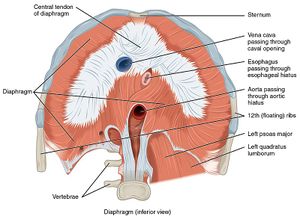Hi-Lo Test: Difference between revisions
(Created page with " {{subst:Special Test}}") |
mNo edit summary |
||
| (4 intermediate revisions by the same user not shown) | |||
| Line 1: | Line 1: | ||
<div class="editorbox"> '''Original Editor '''- [[User: | <div class="editorbox"> '''Original Editor '''- [[User:Lilian Ashraf|Lilian Ashraf]]<br> | ||
'''Top Contributors''' - {{Special:Contributors/{{FULLPAGENAME}}}}</div> | '''Top Contributors''' - {{Special:Contributors/{{FULLPAGENAME}}}}</div> | ||
== Purpose< | == Purpose == | ||
[[File:Diaphragm (inferior view).jpeg|thumb]] | |||
The [[Diaphragm Anatomy and Differential Diagnosis|diaphragm]] is the primary muscle of respiration, when it is functioning normally it produces observable breathing mechanics of abdominal motion, anterior-superior chest expansion, and lateral rib expansion, commonly referred to as “diaphragmatic breathing”.<ref name=":0">Horris H, Anderson BE, Bay RC, Bliven KC. Clinical breathing mechanics differ based on test and position. Journal of Sport Rehabilitation. 2019 Aug 1;28(6):635-9.</ref> | |||
The Hi-Lo Test is used in the assessment of breathing pattern dysfunction, by the observation of abdominal excursion and anterior-posterior chest expansion.<ref name=":0" /> | |||
== Technique == | |||
= | The patient is instructed to place one hand on their chest and the other on their abdomen and breathe normally. Movement in the upper chest and abdomen is observed.<ref name=":0" /> | ||
The patients who functionally breathe display visible abdominal expansion movement and no visible superior migration of the thoracic cage.<ref name=":0" /> | |||
= | {{#ev:youtube| yjLl5NINUEk|300}}<ref> coachkeats. Basic Table Assessments 101 Hi-Lo Breathing Test w/Keats S. Available from: https://www.youtube.com/watch?v=yjLl5NINUEk [last accessed 9/5/2023]</ref> | ||
The test can be done in different positions according to the patient. From supine, sitting or standing. | |||
== | One study at 2019 looked into the effect of different positions on Hi-Lo test results, it found that as postural demand increased from sitting to standing, frequency of functional breathing decreased, due to increased demand on the diaphragm. Which suggests that Hi-Lo test should be performed from different positions to determine whether the diaphragm is able to respond to increased postural demands. | ||
== Evidence == | |||
One study compared Hi-Lo test with [[Manual Assessment of Respiratory Motion (MARM)|MARM]] (Manual Assessment of Respiratory Motion), it found that less experienced practitioners with only a small amount of practice and training can use the MARM and Hi Lo with similar levels of accuracy to experienced practitioners.<ref>Courtney, R., Cohen, M. and Reece, J., 2009. Comparison of the Manual Assessment of Respiratory Motion (MARM) and the Hi Lo Breathing Assessment in determining a simulated breathing pattern. International Journal of Osteopathic Medicine, 12(3), pp.86-91.</ref> | |||
== References == | == References == | ||
<references /> | <references /> | ||
[[Category:Respiratory]] | |||
[[Category:Assessment]] | |||
[[Category:Respiratory System - Assessment and Examination]] | |||
Latest revision as of 01:34, 10 May 2023
Purpose[edit | edit source]
The diaphragm is the primary muscle of respiration, when it is functioning normally it produces observable breathing mechanics of abdominal motion, anterior-superior chest expansion, and lateral rib expansion, commonly referred to as “diaphragmatic breathing”.[1]
The Hi-Lo Test is used in the assessment of breathing pattern dysfunction, by the observation of abdominal excursion and anterior-posterior chest expansion.[1]
Technique[edit | edit source]
The patient is instructed to place one hand on their chest and the other on their abdomen and breathe normally. Movement in the upper chest and abdomen is observed.[1]
The patients who functionally breathe display visible abdominal expansion movement and no visible superior migration of the thoracic cage.[1]
The test can be done in different positions according to the patient. From supine, sitting or standing.
One study at 2019 looked into the effect of different positions on Hi-Lo test results, it found that as postural demand increased from sitting to standing, frequency of functional breathing decreased, due to increased demand on the diaphragm. Which suggests that Hi-Lo test should be performed from different positions to determine whether the diaphragm is able to respond to increased postural demands.
Evidence[edit | edit source]
One study compared Hi-Lo test with MARM (Manual Assessment of Respiratory Motion), it found that less experienced practitioners with only a small amount of practice and training can use the MARM and Hi Lo with similar levels of accuracy to experienced practitioners.[3]
References[edit | edit source]
- ↑ 1.0 1.1 1.2 1.3 Horris H, Anderson BE, Bay RC, Bliven KC. Clinical breathing mechanics differ based on test and position. Journal of Sport Rehabilitation. 2019 Aug 1;28(6):635-9.
- ↑ coachkeats. Basic Table Assessments 101 Hi-Lo Breathing Test w/Keats S. Available from: https://www.youtube.com/watch?v=yjLl5NINUEk [last accessed 9/5/2023]
- ↑ Courtney, R., Cohen, M. and Reece, J., 2009. Comparison of the Manual Assessment of Respiratory Motion (MARM) and the Hi Lo Breathing Assessment in determining a simulated breathing pattern. International Journal of Osteopathic Medicine, 12(3), pp.86-91.







